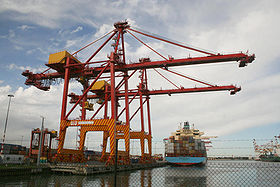| Port of Melbourne | |
|---|---|
 Container crane and ship at Swanson Dock East | |
 Click on the map for a fullscreen view | |
| Location | |
| Location | West Melbourne |
| Coordinates | 37°51′S 144°54′E / 37.850°S 144.900°E[1] |
| UN/LOCODE | AUMEL[2] |
| Details | |
| Built | 1889 |
| Operated by | DP World Patrick |
| Size | 143,000 m2 |
| No. of berths | 31[1] |
| Draft depth | 14.7 m.[1] |
| No. of platforms | 16 |
| Rail gauge | Dual gauge |
| Street access | Docklands Highway |
| Statistics | |
| Annual TEU | 3.02 million[3] |
| Website www | |
The Port of Melbourne is the largest port for containerised and general cargo in Australia.[4] It is located in Melbourne, Victoria, and covers an area at the mouth of the Yarra River, downstream of Bolte Bridge, which is at the head of Port Phillip, as well as several piers on the bay itself. Since 1 July 2003, the Port of Melbourne has been managed by the Port of Melbourne Corporation, a statutory corporation created by the State of Victoria.
Most of the port is in the suburb of West Melbourne and should not be confused with the Melbourne suburb of Port Melbourne although Webb Dock and Station Pier, parts of the Port of Melbourne, are in Port Melbourne.
Port Melbourne (or Sandridge as it was known until 1884) was a busy port early in the history of Melbourne, but declined as a cargo port with the development of the Port of Melbourne in the late 19th century. It retains Melbourne's passenger terminal however, with cruise ships using Station Pier.
Infrastructure Victoria estimate that the Port of Melbourne will reach its capacity in 2055.[5]
In September 2016, the port’s commercial operations were leased to the Lonsdale Consortium for a term of 50 years for more than $9.7 billion.[6][7]
The Lonsdale Consortium comprises
- Global Infrastructure Partners (40%)
- China Investment Corporation (20%)
- NTS, a Korean pension fund (20%)
- Future Fund (20%)
- Queensland Investment Corporation (20%)
- Ontario Municipal Employees Retirement System (20%)
- ^ a b c "Port of Melbourne, Australia". www.findaport.com. Shipping Guides Ltd. Retrieved 8 October 2020.
- ^ "UNLOCODE (AU) - AUSTRALIA". www.unece.org. UNECE. Retrieved 8 October 2020.
- ^ "Trade performance". www.portofmelbourne.com. Retrieved 26 March 2021.
- ^ "Quick facts". www.portofmelbourne.com. Retrieved 11 November 2017.
- ^ "Securing Victorias Ports Capacity" (PDF).
- ^ "Promise Delivered: Port Of Melbourne Leased To Remove Level Crossings And Create Thousands Of Jobs". 19 September 2016. Retrieved 23 September 2016.
- ^ "Chinese fund takes 20% of $7.3bn Melbourne port". 20 September 2016.